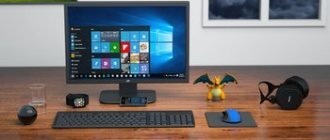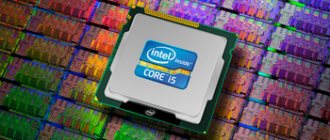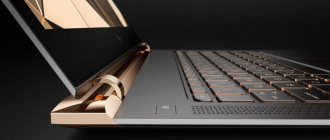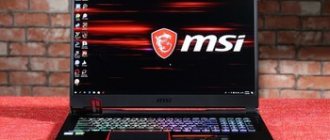Diagonal and screen resolution
At first glance, it seems that the choice is limited by budget and the amount of free space on the table. However, it is worth remembering that the higher the resolution, the greater the load on the video card. One chip will produce a different number of frames per second at Full HD and at QHD. The most popular resolution is 1920x1080 - this is the minimum for modern gaming. Less makes sense only in laptops with a small diagonal. As for sizes, there are many of them: from small 23-inch models to giants like the Samsung C49HG90DMI, which can easily replace two screens.
The best option is a diagonal of 27-32 inches with an aspect ratio of 16:9. Most games are developed based on this format: they will take up the entire screen, without leaving black bars around the edges, and there will be no need for image scaling. If you're going to be playing in 4K, a large 31-40 inch TV-like monitor will work well. However, note that Windows still doesn't adapt well to high resolutions (icons and text become too small), and some games not designed for 4K are severely distorted. The zoom functions do not always help.
Please note that there is no point in high resolution if the diagonal is small. In this case, you will not see all the benefits of high detail. This rule also works in the opposite direction. There is no point in buying a monitor with a large diagonal and low resolution. For example, Full HD doesn’t look the best on a 27-inch screen: many users complain about high graininess, due to the fact that every pixel can be seen with the naked eye.
There is also a format of curved monitors: they differ from flat ones in their smaller viewing angle and body shape. Such a device is worth buying only for gaming - playing behind a curved display while sitting directly in front of it is quite comfortable, due to the fact that the extreme points of the screen are closer to the eye than in the case of a flat monitor. But watching movies, especially in a group, will be inconvenient: half of the picture is not visible from the side of such a screen.
Asus ROG Strix XG438Q
Best giant monitor for gamers
pros
- Ultimate Gaming Performance
- Large size allows you to see enemies better
- Display Widget software provides many customization options
- Suitable for next generation consoles
Minuses
- Display Stream Compression not integrated
- Big enough to make some people dizzy
- Not ideal for professional content creators
- BGR profile makes text a little blurry
Bottom line : If you find your TV too big for gaming and a regular monitor too small, Asus' 43-inch offering is a good alternative for serious gamers. The monitor is not cheap, but worth the money.
Prices for Yandex.Market
Monitor Asus ROG Strix XG438Q
Brightness, contrast and matrix coverage
Choose a model with a brightness of at least 250 cd/m2. During the game you will be close to the monitor and, if necessary, you can reduce it. However, in a room with bright or natural light, high brightness will keep the image on the screen clearly readable. The contrast must be at least 1000:1, otherwise the image will not look sharp enough. We also advise you to pay special attention to the presence of modes to protect your eyesight: they will come in handy during a long game.
The screen coating can be glossy or matte. It is believed that gloss makes the picture “juicier”, but it does reflect a lot. The matte coating will not reflect, but will not embellish the picture. If you play in the evenings and there are no bright light sources or glare in your room, feel free to choose a glossy monitor. If there is always something shining into your screen, it is better to choose a panel with a matte finish.
Philips 243V7QSB 23.8″ is one of the cheapest but high-quality 24-inch monitors
Philips 243V7QSB 23.8″ is one of the most affordable solutions on the market, based on a good IPS matrix with FHD resolution. What distinguishes it from its price competitors is the use of IPS rather than a TN matrix. It produces brighter and more saturated colors with maximum viewing angles. You will be pleased with the brightness reserve, which is enough for any external lighting and the contrast ratio is 1000:1.
The device has the lowest power consumption in our top list at 14 W, but it has a significant drawback - the lack of an HDMI port. Only VGA and DVI-D are available for connection. The frame rate has been increased to 76 Hz, but the response time is inferior to competitors - 8 ms. The LED backlight has no PWM effect, which minimizes eye strain. The package includes an ergonomic stand with a variable tilt angle. Placement is possible both on the table surface and on the wall using a VESA bracket 100x100.
Pros:
- Price;
- Build and image quality;
- Easy;
- Thin;
- Design;
- Excellent color rendition;
- Convenient menu;
- Easy to assemble stand.
Minuses:
- Response 8ms;
- No HDMI.
Gaming monitor matrix type
By and large there are three options: TN, VA and IPS. TN matrices are characterized by low response time and low price: budget models mostly contain TN panels. However, this type has lower contrast (compared to IPS) and smaller viewing angles. VA is an average matrix in terms of characteristics, which is between TN and IPS. In terms of price, it is also in the middle segment. IPS monitors are a little more expensive and not as fast as TN ones. But they have better color rendition and wider viewing angles. For an IPS panel with a response time of 1 ms you will have to pay at least 3,000 more than for a similar model with a TN matrix.
If you play online games and the frame rate counter comes first for you, and the picture quality does not matter at all, feel free to take TN. If you prefer mostly single projects with rich graphics, then take a closer look at VA or IPS.
What to pay attention to
The first thing you should pay attention to when choosing a gaming monitor is the matrix, frequency and VRR support. These three components have the greatest impact on immersion in games.
Matrix
The market offers monitors with IPS, VA and TN matrices. Most TN monitors have low response times, which will be useful for eSports players. TN often stands out for its high refresh rate and low price. But there may be complaints about the picture quality - the color rendition of TN matrices is far from ideal, and the viewing angles are low.
Monitors with a VA matrix are suitable for those who prefer high contrast. Color reproduction is better than TN, but response is often poorer and viewing angles are lower than IPS. Some VA monitors with high refresh rates may suffer from ghosting and blurred images. VA monitors are good for fans of single-player games, but they are not suitable for competitive ones.
IPS corrects the shortcomings of TN - monitors with this matrix have accurate color display and large viewing angles. IPS contrast is lower than VA - this is the only omission. There are a lot of IPS monitors on store shelves with high refresh rates and low response times. They are a little more expensive than their TN counterparts, but for an additional fee the buyer receives a more pleasant and high-quality image.
Frequency
Refresh rate - how many frames per second the monitor can display. The higher this value, the smoother the picture. You need to focus on your video card, because the number of finished frames depends on it. If your computer has a powerful GPU that can produce high FPS in all modern games, feel free to consider monitors with 120 Hz and higher. The same advice will be useful for eSports players with an average video card - competitive games are often less GPU-demanding than fancy AAA projects.
VRR support
Many games have a V-Sync option in the settings. It limits the number of frames that the video card can draw, adjusting to the monitor's refresh rate. V-Sync combats tearing - a phenomenon in which the image is “torn” due to the fact that the next frame is drawn instead of the current one, and the monitor does not have time to display each of them entirely. The price of the solution is increased input lag.
VRR or Variable Refresh Rate is a technology that allows a monitor to change its refresh rate. The effect is the same as with V-Sync enabled, but there are no input lags. In gaming monitors, VRR is called differently: FreeSync or G-Sync. Different technologies are compatible with different video cards, please do your research before purchasing. For example, FreeSync works with NVIDIA video cards only starting from the 1000 series and only through a DisplayPort connection.
Frame Rate (Hz)
The frame rate is measured in Hertz and represents the number of frames a monitor can display in one second. The minimum for gaming is 60 Hz, but this value is only suitable for single games. In online battles, where there are many dynamic scenes, the smoothness of the picture is much more important. Therefore, it is better to choose 120, 144 or even 240 Hz displays.
At the moment, 240 Hz is the highest frequency that can be found on the market. Devices with this indicator are much more expensive than their slower counterparts. The cheapest 240 Hz monitor costs 20,000 rubles - this is the Acer KG251QDbmiipx with a diagonal of 27 inches and Full HD resolution. Monitors with 144 Hz are especially popular: the choice in this segment is much greater than among models with support for 240 Hz, you can even find devices with a diagonal of up to 49 inches.
Viewsonic VA2432-H 23.8″ with Eye-Care technology and energy-saving Eco mode
The review moves on to an inexpensive but good model from ViewSonic with a 24-inch diagonal and FHD resolution. This is a high-quality IPS matrix with excellent viewing angles and natural color reproduction. The new product is perfect for games, work and home. SuperClear® IPS technology makes images clearer and more detailed.
The three-sided frameless design makes the Viewsonic VA2432-H 23.8″ more beautiful and convenient to use. There are 6 ViewMode presets, which allows you to set the optimal option depending on the current operating conditions. An HDMI cable is provided for connection. Frame rate is 75 Hz with a response time of 4 ms. Eye-Care technology minimizes eye fatigue when working on a PC for long periods of time.
Pros:
- Light and thin;
- Barely noticeable frames;
- Color rendering;
- Variety of settings;
- Technologies for vision protection;
- Response time 4 ms;
- There are all the current options - Eye-Care, SuperClear® IPS, Eco and much more;
- Honest 75 Hz.
Minuses:
- Short power cable.
G-Sync/FreeSync support
Video card manufacturers have developed adaptive synchronization technologies, with the support of which the monitor provides the smoothest picture possible. NVIDIA has G-Sync, and AMD has FreeSync. Models with G-Sync are more expensive, but they work with popular gaming video cards from NVIDIA.
On paper, the benefits of adaptive synchronization are obvious, but gamers are still arguing whether it makes sense in practice. We recommend choosing a monitor that supports G-Sync/FreeSync to eliminate image tearing and other visual defects using these technologies. In addition, hardware and video card drivers are regularly updated, which means frame synchronization technologies will also improve.
HDR
HDR technology doesn't just make movies and TV shows look better. It can turn dark, blurry games into something more vibrant, contrasty, with clear edges of all objects. There are currently four levels of HDR monitors: DisplayHDR 400, DisplayHDR 600, DisplayHDR 1000, DisplayHDR 1600. The number represents brightness in nits.
While there are plenty of 4K HDR monitors out there, Windows' HDR implementation leaves a lot to be desired. If the technology worked as it should, applications would support HDR, just like the system itself.
Gaming consoles like the Xbox One X and PlayStation 4 Pro have no problem applying HDR to most games. Computer games lag behind in this regard, and the number of monitors with HDR support is also small. There are just over 100 games on computers with HDR, the level of implementation of the technology in them differs. When this implementation is at a high level, HDR enhances the gaming experience.
Connection
Modern video cards use HDMI, DVI, DisplayPort and Mini DisplayPort connectors. VGA is already rare. To transmit 4K 30 fps, you will need support for HDMI 1.4, for 4K 60 fps - HDMI 2a or Displayport 1.3/1.4.
- Technologies
What is HDMI? Comparing cable types
Also, many gaming monitors are equipped with built-in speakers, a headphone jack, USB-A and USB-C ports, which allow you to connect peripherals or charge your smartphone. Additional functionality should be selected as needed. However, we note that the built-in speakers in the vast majority of cases will not have the best sound.
AOC 24V2Q 23.8″ - sleek and ultra-thin 7.7 mm case
A gaming monitor under 10,000 rubles is distinguished by an almost complete absence of frames. It supports Low-blue Light and AMD FreeSync technologies, and colorful and detailed images are broadcast on a 23.8-inch IPS screen with FHD resolution. The thin body is located on an elegant “leg” with the ability to change the angle of inclination. All connection connectors are built into the rack - Displayport, HDMI and 3.5mm mini-Jack for a headset or external speakers.
The display features natural color reproduction, a brightness reserve of 250 cd/m² and maximum viewing angles in all directions. Response time: 5 ms at 75 Hz frame rate. Low Blue Mode minimizes blue light, reducing eye fatigue. AOC 24V2Q 23.8″ has a minimum power consumption of 18 W.
Pros:
- Energy efficiency;
- Ultra-thin body;
- Value for money;
- Abundance of available settings;
- Nice colors;
- Functions aimed at protecting vision.
Minuses:
- Cannot be installed on a wall;
- The stand gets scratched quickly.
Overall: what a good gaming monitor should be like
A properly selected gaming monitor will have the following characteristics: a diagonal of at least 27 inches with an aspect ratio of 16:9, a response time of 1-5 ms, a frame refresh rate of 60 Hz, support for G-Sync/FreeSync and the presence of HDMI and DisplayPort interfaces for connecting modern video cards All other parameters (for example, the appearance of the device and additional connectors) depend on your taste and budget. So that you don’t have to choose for a long time, we have compiled a small top monitors.
Acer ET221Qbi 21.5″ is the most compact model on our list
Acer ET221Qbi has a miniature 21.5-inch screen made using IPS technology. The matrix is surrounded by small frames, and the benefits include wide viewing angles, rich and realistic colors. The quality of detail is at the highest level - FHD resolution is plenty for such a diagonal.
Response time is kept to a minimum of 4 ms, which is especially good when playing dynamic scenes. The device reduces eye fatigue by reducing harmful blue light and preventing PWM. There are two connectors available for connection - HDMI and VGA. The display is placed on a rectangular stand that allows you to tilt it 5 degrees forward and 20 degrees back. An alternative option is to mount it to the wall using a VESA bracket of 100x100 mm format.
Pros:
- Fast response 4ms;
- Appearance;
- The screen does not flicker;
- Compact and lightweight;
- Detail and saturation of the picture;
- Reliable stand;
- Contrasting;
- Intuitive menu;
- Integrated power supply.
Minuses:
- No HDMI included;
- The buttons are placed in an unfortunate way.
The best gaming monitors of 2021: model ratings
Iiyama G-Master G2730HSU-1
The gaming monitor from Iiyama meets all our requirements: it is a 27-inch diagonal TN panel, decent resolution (1920x1080 pixels), FreeSync support and a low response time of 1 ms. HDMI, DisplayPort and even VGA connectors are used to connect to a computer. Plus, there are speakers and a USB hub. Moreover, the model costs only 13,000 rubles.
HP OMEN 27
An almost frameless gaming monitor from HP based on a TN matrix with a 2K resolution is suitable for shooters and racing. The 165Hz frequency, 1ms response time and G-Sync support promise smooth images even in fast-paced gaming scenes.
AOC G2590FX
If you are looking for a small gaming monitor, pay attention to the model from the popular manufacturer AOC. The 24.5-inch matrix looks very unusual: it has almost no frames. The resolution matches the screen size - Full HD. Other characteristics are at the level of top models: 1 ms, 144 Hz, FreeSync support.
MSI Optix AG32CQ
The curved monitor with a diagonal of 31.5 inches is distinguished by an unusual type of matrix for a gaming device - VA, which provides a response time of 1 ms and good color rendition. There's also FreeSync support and a high refresh rate of 144Hz.
Xiaomi Redmi Display 1A
As a budget solution for an inexperienced gamer, products from the affordable Xiaomi brand are suitable. It cannot be said that this model stands out from the rest in any way (except perhaps for its low price), but it is equipped with the most minimal set of necessary characteristics. Polling rate - 60 Hz, brightness - 250 cd/m², matrix - IPS.
Xiaomi Mi Surface Display
But you shouldn’t associate the Chinese corporation only with budget devices. Here is a model for 34,000 rubles, which has excellent characteristics and offers gamers 4K resolution, a high contrast ratio of 3000:1 and a refresh rate of 144 Hz. Almost all reviews of the model are extremely positive.
BEST ULTRA WIDE
Samsung C49RG90
Model C49RG90 is a must-have for those who need a large ultra-wide monitor. Yes, you can buy a full-fledged PC for this money, but the device is really worth it. It is ideal for both gaming and video editing.
It has a 49-inch VA panel with a resolution of 5120 x 1440 . Two important technologies for gamers are supported - FreeSync 2 HDR and G-Sync from NVIDIA . The maximum screen refresh rate is 120 Hz .
Cost : from 80,000 rubles
TOP 4 best cheap monitors under 5000 rubles
AOC e970Swn
Equipped with a 19-inch TN+film matrix with anti-glare coating with a resolution of 1366x768 pixels. Brightness - 200 cd/m2. Contrast - 700:1, dynamic - 200000000:1. Viewing angles - 90 and 65 degrees horizontally and vertically. Refresh rate - 76 Hz. Response time: 5 ms. The characteristics for this type of matrix are not bad. The image is detailed, worthy of a budget monitor, but there are problems with color reproduction and a sharp deterioration in image quality when changing the viewing angle. Connection is via VGA only. Installation - on a stand (included) or on a wall (VESA mount 100x100 mm, sold separately). Price - 3900 rubles.
Pros:
- price;
- compactness;
- quick response.
Minuses:
- poor color rendering;
- small viewing angles;
- incomprehensible one-button setup;
- It is impossible to adjust the screen height (only the tilt angle);
- connection - only via VGA.
The monitor is worth its price. I can recommend it to those who are on a very limited budget. Suitable for office and simple home work, but given the low image quality, color rendering can negatively affect vision. I don’t recommend working with it for a long time without rest; it’s better to take a more expensive model, for example, ASUS VP228DE.
Reviews on Yandex.Market
Acer K192HQLb
Another inexpensive model that does not shine with technical characteristics. It differs from AOC e970Swn:
- greater dynamic contrast, which in practice is not felt in such monitors;
- the ability to adjust the screen tilt angle in the range from -5° to 25°;
- flexible and understandable image settings.
Connects via VGA. Can be installed on a VESA 100x100mm bracket. Price - 4060 rubles.
Pros:
- price;
- compactness;
- quick response.
Minuses:
- poor color rendering;
- small viewing angles;
- connection - only via VGA;
- It is impossible to adjust the screen height (only the tilt angle).
A compact monitor worthy of placement in the office and at home for undemanding users (surfing, working with documents). Judging by the ratings of Yandex users. The Market has better image quality and color rendition than the AOC e970Swn, it is still far from ideal, but the overpayment of 160 rubles is definitely worth it.
Reviews on Yandex.Market
ASUS VP228DE
The model is suitable even for unpretentious gamers. Focusing on this, the company equipped it with ASUS GamePlus technology - crosshair display (four options) and a timer. For user convenience, it is possible to change image settings in accordance with current tasks with one button. 8 preset modes are available.
Technical characteristics: diagonal - 22 inches, resolution - Full HD. Response time: 5 ms. Refresh rate - 60 Hz. There is Flicker-Free anti-flicker protection and blue spectrum filtering - additional protection for the user's eyes. The monitor has 1 VGA connector. Installed on a tilt-adjustable stand or on a VESA 100x100 mm bracket. Price - 4900 rubles.
Pros:
- resolution - Full HD;
- fast response;
- gaming features;
- Flicker-Free anti-flicker;
- Blue spectrum filtering.
Minuses:
- poor color rendering;
- small viewing angles;
- connection - only via VGA;
- Screen height cannot be adjusted (only tilt angle).
A universal monitor for home, office, suitable for a novice gamer. Equipped with technologies that reduce the negative impact on the user’s vision. If possible, it is better to overpay a few hundred rubles and take the Viewsonic VA2261. This is evidenced by higher ratings from Yandex users. Marketa.
Reviews on Yandex.Market
Viewsonic VA2261-2
Like the previous participant in the rating, the monitor has a 22-inch diagonal, similar to a Full HD TN matrix with anti-flicker protection, but with a refresh rate of 75 Hz. This is an added benefit for gamers. The second bonus is built-in 4 W acoustics. It will be difficult to use it constantly due to the low sound quality, but before purchasing external acoustics it will come in very handy. Unlike the ASUS VP228DE, it connects to a PC via VGA and DVI-D. Price - 5100 rubles.
Advantages:
- good view;
- not bulky;
- thin frame around the screen;
- good price.
Flaws:
- with the minimum brightness set it is still too bright;
- very small viewing angles.
A good monitor for simple tasks. Can be used by gamers: the 75 Hz refresh rate is beneficial here. But the monitor lacks the gaming features available in the ASUS VP228DE. Although it is unlikely that a serious gamer will use such a monitor in 2021. Its purpose is rather everyday tasks with elements of gaming.
Reviews on Yandex.Market
Iiyama ProLite XU2493HSU-B1 23.8″ - good color rendering and flexible settings
When choosing a budget monitor for a PC, you should pay attention to the Iiyama ProLite XU2493HSU-B1 - a 23.8-inch model made on the basis of a high-quality IPS matrix. The image is distinguished by its naturalness and high elaboration thanks to the resolution of 1920x1080 pixels. The case is painted in classic black color, and durable plastic is used for its manufacture.
| This is interesting: A list of the best convertible laptops has been published |
The device can be placed on any surface using a stand or attached to a wall using a VESA 100x100 bracket. The stand has an inclination angle from -3.5 to +21.5 degrees. Uniform illumination guarantees the convenience of working at the computer at any time of the day, and viewing angles are limited to 178 degrees. Accordingly, the picture is not distorted no matter where you look at it in the room. For connecting to external devices, D-SUB, HDMI and Display Port ports are provided. The 75Hz refresh rate is combined with a fast response time of 4ms.
Pros:
- Good monitor for affordable money;
- Possibility of mounting on a bracket or stand;
- Sturdy outer frame;
- Stand tilt angle from -3.5 to +21.5 degrees;
- Picture quality and color rendition;
- Modern ports for connection;
- Long warranty from the manufacturer;
- Fast response of 4 ms.
Minuses:
- Inconvenient location of control keys.











